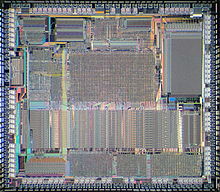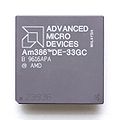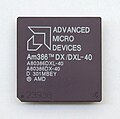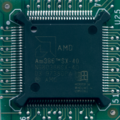|
Am386
The Am386 CPU is a 100%-compatible clone of the Intel 80386 design released by AMD in March 1991. It sold millions of units, positioning AMD as a legitimate competitor to Intel, rather than being merely a second source for x86 CPUs (then termed 8086-family).[1] History and design  While the AM386 CPU was essentially ready to be released prior to 1991, Intel kept it tied up in court.[2] Intel learned of the Am386 when both companies hired employees with the same name who coincidentally stayed at the same hotel, which accidentally forwarded a package for AMD to Intel's employee.[3] AMD had previously been a second-source manufacturer of Intel's Intel 8086, Intel 80186 and Intel 80286 designs, and AMD's interpretation of the contract, made up in 1982, was that it covered all derivatives of them. Intel, however, claimed that the contract only covered the 80286 and prior processors and forbade AMD the right to manufacture 80386 CPUs in 1987. After a few years in the courtrooms, AMD finally won the case and the right to sell their Am386 in March 1991.[4] This also paved the way for competition in the 80386-compatible 32-bit CPU market and so lowered the cost of owning a PC.[1] While Intel's 386 CPUs had topped out at 33 MHz in 1989, AMD introduced 40 MHz versions of both its 386DX and 386SX out of the gate, extending the lifespan of the architecture. In the following two years the AMD 386DX-40 saw popularity with small manufacturers of PC clones and with budget-minded computer enthusiasts because it offered near-80486 performance at a much lower price than an actual 486.[5] Generally the 386DX-40 performs nearly on par with a 25 MHz 486 due to the 486 needing fewer clock cycles per instruction, thanks to its tighter pipelining (more overlapping of internal processing) in combination with an on-chip CPU cache. However, its 32-bit 40 MHz data bus gave the 386DX-40 comparatively good memory and I/O performance.[6]
Am386DX data
Am386DE data
AM386 SXIn 1991 AMD also introduced advanced versions of the 386SX processor – again not as a second source production of the Intel chip, but as a reverse engineered pin compatible version. In fact, it was AMD's first entry in the x86 market other than as a second source for Intel.[7] AMD 386SX processors were available at higher clock speeds at the time they were introduced and still cheaper than the Intel 386SX. Produced in 0.8 μm technology and using a static core, their clock speed could be dropped down to 0 MHz, consuming just some mWatts. Power consumption was up to 35% lower than with Intel's design and even lower than the 386SL's, making the AMD 386SX the ideal chip for both desktop and mobile computers. The SXL versions featured advanced power management functions and used even less power.[7]
Am386SX data
80387 coprocessorFloating point performance of the Am386 could be boosted with the addition of a 80387DX or 80387SX coprocessor, although performance would still not approach that of the on-chip FPU of the 486DX. This made the Am386DX a suboptimal choice for scientific applications and CAD using floating point intensive calculations. However, both were niche markets in the early 1990s and the chip sold well, first as a mid-range contender, and then as a budget chip. Although motherboards using the older 386 CPUs often had limited memory expansion possibilities and therefore struggled under Windows 95's memory requirements, boards using the Am386 were sold well into the mid-1990s; at the end as budget motherboards for those who were only interested in running MS-DOS or Windows 3.1x applications. The Am386 and its low-power successors were also popular choices for embedded systems, for a much longer period than their life span as PC processors.
References
External linksWikimedia Commons has media related to AMD Am386.
|
|||||||||||||||||||||||||||||||||||||||||||||||||||||||||||||||||||||||||||||||||||||||||||||||||||||||||||||||||||||||||||||












